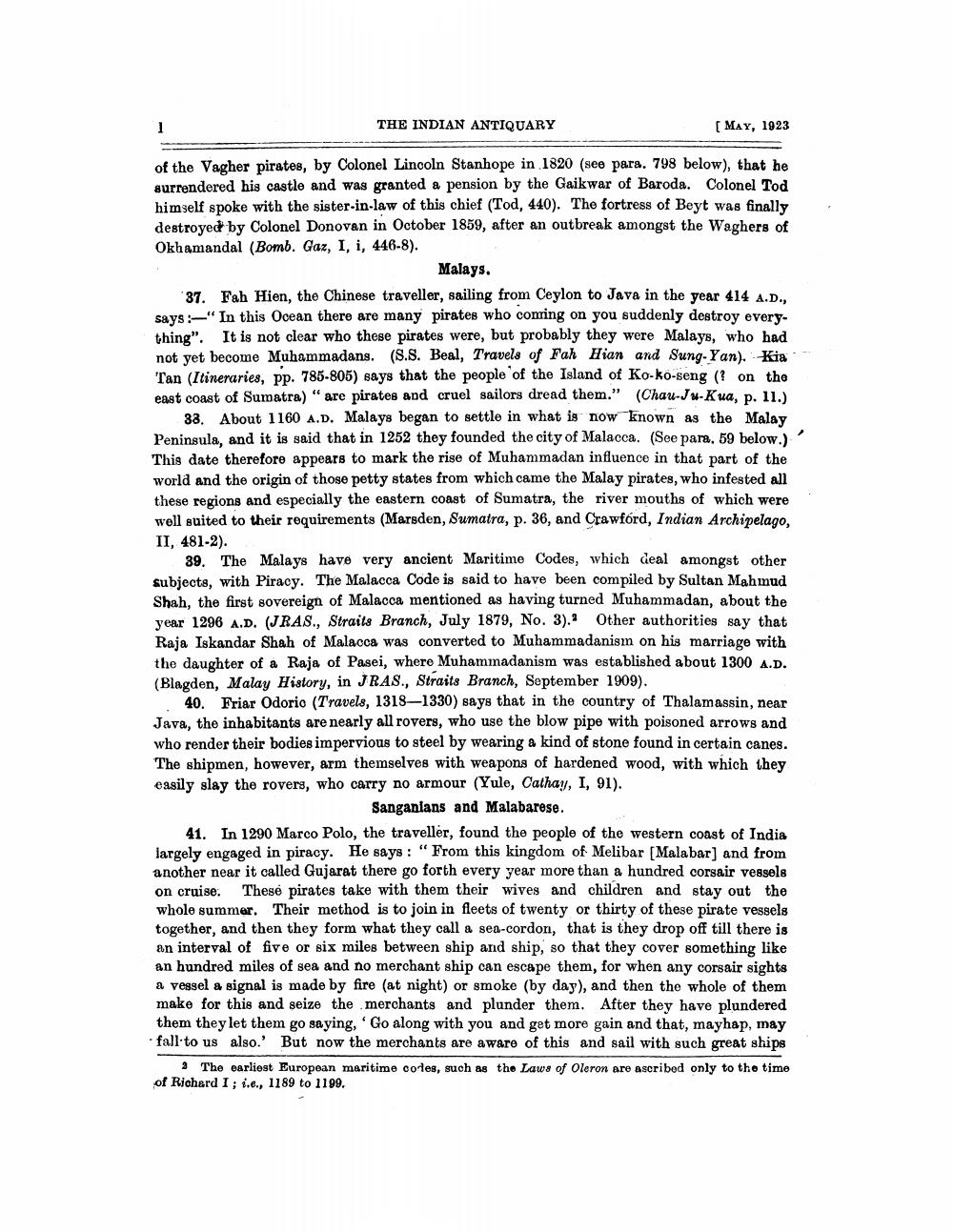________________
THE INDIAN ANTIQUARY
[ May, 1923
of the Vagher pirates, by Colonel Lincoln Stanhope in 1820 (see para. 798 below), that he aurrendered his castle and was granted a pension by the Gaikwar of Baroda. Colonel Tod himself spoke with the sister-in-law of this chief (Tod, 440). The fortress of Beyt was finally destroyed by Colonel Donovan in October 1859, after an outbreak amongst the Waghers of Okhamandal (Bomb. Gaz, I, I, 446-8).
Malays. 37. Fah Hien, the Chinese traveller, sailing from Ceylon to Java in the year 414 A.D., says "In this Ocean there are many pirates who conring on you suddenly destroy everything". It is not clear who these pirates were, but probably they were Malays, who had not yet become Muhammadans. (S.S. Beal, Travels of Fah Hian and Sung.Yan). Kia -- Tan (Itineraries, pp. 785-805) says that the people of the Island of Ko-ko-seng ( on the east coast of Sumatra)" are pirates and cruel sailors dread them." (Chau-Ju-Kua, p. 11.)
88. About 1160 A.D. Malays began to settle in what is now known as the Malay Peninsula, and it is said that in 1252 they founded the city of Malacca. (See para, 59 below.)? This date therefore appears to mark the rise of Muhammadan influence in that part of the world and the origin of those petty states from which came the Malay pirates, who infested all these regions and especially the eastern coast of Sumatra, the river mouths of which were well suited to their requirements (Marsden, Sumatra, p. 36, and Crawford, Indian Archipelago. II, 481-2).
39. The Malays have very ancient Maritime Codes, which deal amongst other subiects, with Piracy. The Malacca Code is said to have been compiled by Sultan Mahmud Shah, the first sovereign of Malacca mentioned as having turned Muhammadan, about the year 1296 A.D. (JRAS., Straits Branch, July 1879, No. 3).' Other authorities say that Raja Iskandar Shah of Malacca was converted to Muhammadanism on his marriage with the daughter of a Raja of Pasei, where Muhammadanism was established about 1300 A.D. (Blagden, Malay History, in JRAS., Straits Branch, September 1909).
40. Friar Odorio (Travels, 1318-1330) says that in the country of Thalamassin, near Java, the inhabitants are nearly all rovers, who use the blow pipe with poisoned arrows and who render their bodies impervious to steel by wearing a kind of stone found in certain canes. The shipmen, however, arm themselves with weapons of hardened wood, with which they easily slay the rovers, who carry no armour (Yule, Cathay, I, 91).
Sanganlans and Malabarese. 41. In 1290 Marco Polo, the traveller, found the people of the western coast of India largely engaged in piracy. He says: "From this kingdom of Melibar [Malabar] and from another near it called Gujarat there go forth every year more than a hundred corsair vessels on cruise. These pirates take with them their wives and children and stay out the whole summer. Their method is to join in fleets of twenty or thirty of these pirate vessels together, and then they form what they call a sea-cordon, that is they drop off till there is an interval of five or six miles between ship and ship, so that they cover something like an hundred miles of sea and no merchant ship can escape them, for when any corsair sights a veggel a signal is made by fire (at night) or smoke (by day), and then the whole of them make for this and seize the merchants and plunder them. After they have plundered
them they let them go saying, 'Go along with you and get more gain and that, mayhap, may - fall to us also. But now the merchants are aware of this and sail with such great ships
2 The earliest European maritime cordes, such as the Laws of Oleron are ascribed only to the time of Richard I ; i.e., 1189 to 1199.




